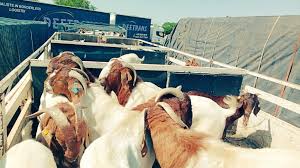Essentials of buck selection, management in goat farming
We are excited about the incredible response from both prospective and current small livestock farmers who have reached out to express their appreciation for the knowledge and experiences we are sharing through the column, as well as for posing further questions.
This week, one of the most common inquiries we received pertains to the selection of bucks or rams when starting small ale stock farming. In response, we have dedicated this instalment to the topic of buck selection and management specifically in goat farming.
As the adage goes, “The buck is half the herd”. This emphasises the crucial role that bucks play in shaping the future of the goat herd. As the herd sire, the buck is the most important animal in the herd as it contributes 50 percent of the genetic makeup of every offspring that is born. Moreover, the buck’s genetics will be spread over many more offspring when compared with the doe.
For instance, a doe contributes on average 6 to 12 kids during its breeding life while a buck contributes 60 to 100 kids per year. The genetic improvement in any herd or flock, therefore, hinges upon the kind of male that is selected for breeding.
Additionally, the buck plays a pivotal role in influencing the overall pregnancy rate of the herd. Selecting high-quality breeding stock is crucial in both meat and dairy goat operations. A replacement herd sire or buckling can be chosen from the contemporary group at weaning, typically occurring at 3 to 4 months of age, with emphasis placed on weaning weight.
Following this, a post-weaning growth assessment can be conducted by 6 to 8 months of age. By 10 months of age, a buckling can commence servicing a small number of females. Since male goats generally reach puberty earlier than females, it is advisable to raise bucks separately from females to prevent unintended mating.
In commercial settings, breeding values and comprehensive farm records are crucial for selecting bucks, but in smallholder settings, visual selection is more common and practical.
Bucks are considered mature at two years old and capable of servicing up to up to 50 does in open mating setups.
When selecting bucks, farmers should consider the following key criteria:
Firstly, the buck should exhibit all the breed characteristics, commonly referred to as conformation. This includes factors such as body shape, size and proportion, which are indicative of the breed is standard. Secondly, it should be at least one year old, with preference given to bucks from twin or triplet births.
Bucks from multiple births often exhibit greater vigour and vitality.
The buck should be the heaviest in the flock since a higher weight indicates better growth potential and overall health. Additionally, a buck should be free from physical defects and diseases. Any visible defects or signs of illness can significantly impact the buck’s ability to perform as a breeder.
Aggressiveness in the buck is desirable, as it can indicate dominance and assertiveness, traits that are beneficial for breeding success. Moreover, the buck should display good health with a straight body and legs. Any abnormalities in posture or gait may indicate underlying health issues that could affect breeding performance.
Furthermore, ruggedness in the neck and shoulders is indicative of strong breeding ability.
These areas often show physical signs of muscling and strength, which are essential for successful mating. A wide chest is preferred as it allows for better lung capacity and overall physical strength, both of which are important for breeding activity.
A shiny coat indicates good health, reflecting proper nutrition and overall well-being. It is a visual indicator of the buck’s ability to thrive in its environment.
Lastly, the buck should exhibit good semen characteristics, including volume, motility, and morphology, as high-quality semen is crucial for successful fertilisation and reproductive efficiency in the herd. Therefore, in addition to the physical examination of the buck, veterinarians can also perform a comprehensive breeding soundness exam (BSE).
This involves examining the semen for sperm count and motility, providing valuable insights into the buck’s fertility.
A thorough BSE assesses various parameters of semen quality, including concentration, morphology, and viability of sperm cells. By analysing these factors, veterinarians can accurately evaluate the reproductive health and potential breeding performance of the buck.
This detailed examination ensures that only fertile and reproductively fit bucks are selected for breeding purposes, ultimately optimising the breeding programmes success.
Farmers should look out for culling defects for bucks. These include those displaying poor conformation, such as cryptorchidism, a genetic malformation where one or no testicles descend into the scrotum. Additionally, eliminates bucklings with hypoplasia or undeveloped testicles, as these conditions typically signify genetic abnormalities.
Keep a lookout for orchitis, an inflammation of the testicles, which can lead to sterility. These criteria ensure the retention of only the healthiest and most genetically sound bucks in the herd.
We always advise budding farmers that if they have a limited budget, they should prioritise investing in a high-quality pedigree or stud buck to enhance their genetics.
Pairing such a buck with average local does, especially those with previous birthing experience, can yield remarkable results.
When a purebred buck crossbreed with an average does, the progeny often exhibit exceptional qualities, benefiting from the superior genetics introduced by the buck.
This strategy allows farmers to maximise genetic improvement even with limited resources.-herald











